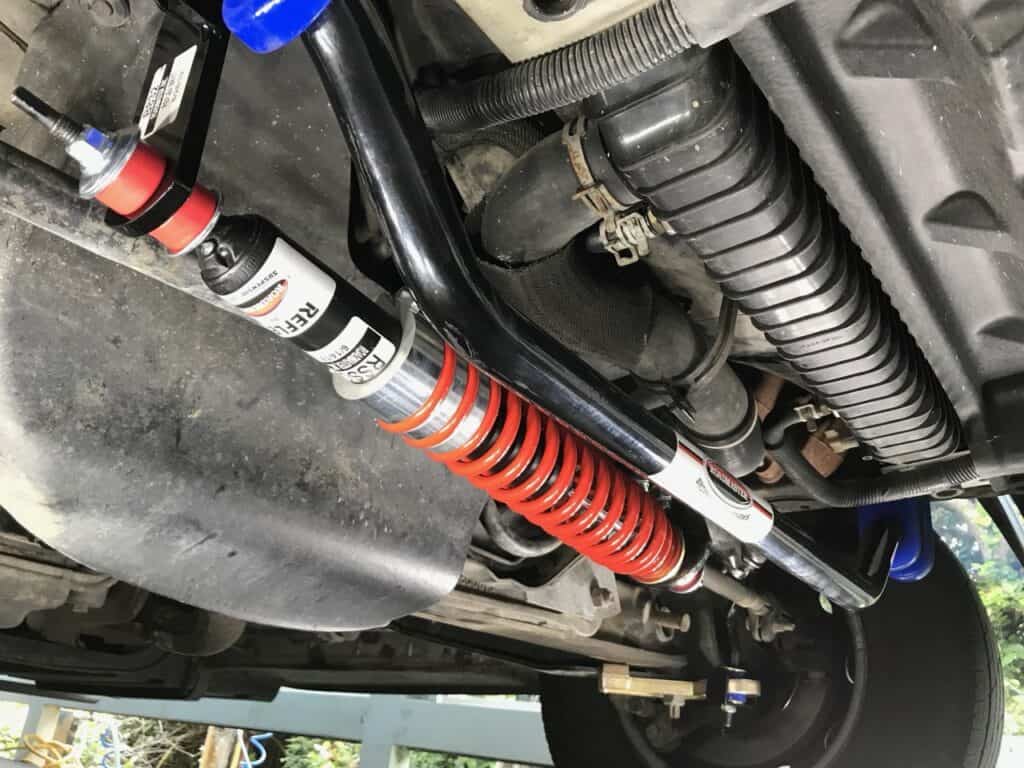Should You Install a Steering Stabilizer on Your RV or Tow Vehicle?
Safety should be the number one priority of every person sitting behind the wheel. One piece of equipment that helps is a steering stabilizer. It’s is a shock-absorber setup that attaches to a vehicle’s steering linkage under the chassis. A steering stabilizer is usually part of a heavy-duty pickup’s or motorhome’s factory steering systems.
“A steering stabilizer helps reduce the effects of rut tracking, road wander, pot holes, expansion joints, crosswinds, wind push from passing big rigs, and driver oversteering,” says Tommy Henderson, the research and development engineer at Henderson’s Line-Up, Brake and RV in Grants Pass, Oregon.
“Most coaches do not come equipped with a true steering stabilizer, but some come with a steering damper. The difference between a steering stabilizer and steering damper is that a damper is simply a shock absorber mounted to the steering, which doesn’t provide any self-centering force. This self-centering force helps the driver maintain control in the event of a front tire blowout.
“A true steering stabilizer, one with a built-in spring, provides a self-centering force in the steering that improves the tendency for the steering wheel to center itself after a turn,” adds Henderson. “While this self-centering tendency is primarily a function of the front-end alignment, specifically the caster. Sometimes there are limitations to how much caster can be built into the front end. A self-centering steering stabilizer will help make up for what is lacking in the caster, greatly improving the return to center and reducing driving fatigue,” explains Henderson.
What Is A Steering Stabilizer?
A steering stabilizer is a shock absorber that’s mounted to the steering linkage. The internal valving dampens the movement of the entire assembly.
Similar to shock absorbers, there’s a variety from which to choose depending on the quality, design, and function. The majority of OEM steering stabilizers are “base” versions that do the minimum when they are new. However, they can wear out quickly. This leads to driver and passenger fatigue.

This also affects tow vehicles like pickups and SUVs. When you tow a larger trailer, it’s more important to have a quality steering-stabilizer setup. Companies that offer them include Fox, Skyjacker, Monroe and Bilstein. Steering stabilizers do wear out as mileage increases.
Upgrade Steering Stabilizers To Improve RV Ride Quality
A quick way to improve an RV’s handling is to replace the OEM steering stabilizer with a heavy-duty version. Examples include the Safe-T-Plus Precision Steering Control or the Roadmaster Reflex Steering Stabilizer.
The Safe-T-Plus and Reflex stabilizers use higher-quality components than the typical OEM versions. Some may have a spring assembly over the shock body. That increases control and helps bring steering back to center. Those with a coil spring also help improved control in the event of a tire blowout.

The typical RV DIYer should be able to remove the old stabilizer and install a new one in less than an hour. Many RV centers can do the job in about a ½-hour.
Steering Stabilizer Install Tips
Always read the instructions thoroughly before doing the job. The less sophisticated stabilizers are super easy to remove and replace with a higher quality version. The more elaborate systems take a little more time—and maybe a tool or two that’s not common in an RVers toolbox.

“One tool that the DIYer has to have (or rent) is a torque wrench,” says Don Palmer, the RV chassis technician at Bish’s RV in Meridian, Idaho. Don was installing a Safe-T-Plus stabilizer on a 2021 Jayco Alante 29S.
“The nuts for the main ‘anchor’ bracket must be torqued to 250 ft-lbs, and most RV owners don’t have one of those in their tool box. The other is a ¾-inch impact gun (or big, long-handle ratchet) and a 1 1/8-inch socket to get the nuts off the rear axle spring U-bolt on the driver’s side.”
Tools can be borrowed through loaner programs offered by local auto parts stores. Those include O’Reilly Auto Parts, AutoZone, or Advance Auto Parts.

Bonus Tip: Check Your RV’s Alignment First
Many RV techs recommend having your RV’s wheel alignment and tie-rod ends checked before installing a new steering stabilizer. If the tie-rod ends are worn and/or the front end is misaligned, the benefits of the upgrade will not be fully realized.
After installing a steering stabilizer, the improvement in control behind the wheel is surprising. It’s well worth the investment.
The post Should You Install a Steering Stabilizer on Your RV or Tow Vehicle? appeared first on RV LIFE.
Source: https://rvlife.com/should-you-install-a-steering-stabilizer-on-your-rv-or-tow-vehicle/








